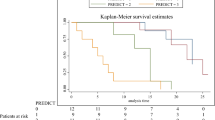Summary
A teleological class of prognostically relevant informations represent the individual medical prognosis. Based on this hypothesis the article analyzes the logical structure of the individual medical prognosis and describes a generalized model of prognostic reasoning in clinical medicine. The individual clinical course, the individual patient model, and clinical expectations of characteristic structure are the basic elements of the model. The application of the model is operationalized by an algorithm.
Similar content being viewed by others
Literatur
Allen, J. F. (1984) Towards a general theory of action and time. Artif. Intell. 123–154.
Allen, J. F.; Hayes, P.J. (1989) Moments and points in an intervall-based temporal logic. Computational Intelligence, pp 225–238.
Benthem, J. F. A. K. van (1992) The Logic of Time, A Model-Theoretical Investigation into the Varieteis of Temproal Ontology and Temporal Discourse. 2nd edition, pp 113–115. Reidel Publ., Dordrecht.
Boring, J. R; Francis, J. B.; Simon, D. G. (1998) Analytic medicine. In: Hurts, J. W. (ed). Medicine for the Practicing Physician. 2nd Edition, pp 5–12. Butterworths, Boston.
Christakis, N. A.; Iwashyna, T. J. (1998) Attitude and self-reported practice regarding prognostications in a national sample of internists. Arch Intern. Med. 2389–2395.
Christakis, N. A. (1997) The ellipsis of prognosis in modern medical thought. Soc. Sci. Med. 301–315.
European Carotid Surgery Trialist Collaborative Group (1991) MCR European Carotid trial: interim results for symptomatic patients with severe (70–99%) or with mild (0–29%) carotid stenosis. Lancet. 1235–1243.
Das, A. K.; Musen, M. A. (1997) A foundational model of time for heterogeneous clinical databases. Proc. AMIA Annu Fall Symp. 106–110.
Fletcher, G. F.; Hurst, J. W. (1988) Prolonged myocaridal ischemia without objective signs of infarction. In: Hurts, J. W. (ed). Medicine for the Practicing Physician. 2nd Edition, pp 1043–1050. Butterworths, Boston.
Green, H. L. (1990) Sudden arrhythmis cardiac death — mechanisms, resuscitation and classification: The Seatle perspective. Am. J. Cariol. 4 b–12 b.
Harrel, F. E. jr.; Lee, K. L.; Mark, D. B. (1996) Multivariable prognostic models: Issues in developing models, evaluationg assumpptions and adequacy, and measuring and reducing errors. Stat. Med. 361–387.
Helmer, O.; Rescher, N (1959) On the epistemology of inexact sciences. Management Science. (5): 25–52.
Hucklenbroich, P. (1998) Steps towards a theory of medical practice. Theor Med. Bioeth. 19: 215–238.
Knapp, H. G. (1978) Logik der Prognose, Semantische Grundlagen technologischer und sozialwissenschaftlicher Vorhersagen. Verlag Karl Alber, Freiburg/München.
Komorowski, J.; Ohrn, A. (1999) Modelling prognostic power of cardiac tests using rough sets. Artif. Intell Med. (15): 167–191.
Ngo, L.; Haddawy, P.; Kriger, R. A.; Helwig, J. (1997) Efficient temporal probabilistic reasoning via context-sensitive construction. Comput Biol Med. 76–81.
Nguyen, J. H.; Shahar, Y.; Tu, S. W.; Das, A. K.; Musen, M. A. (1997) A temporal database mediator for protocol-based decision support. Proc AMI Annu Fall Symp. 298–302.
North American Symptomatic Carotid Endarterectomy Trial Collaboratiors (1991), Beneficial effect of carotid endarterectomy in symptoamtic patients with high-grade carotid stenosis. N. Eng. J. Med. 445–453.
Pappas, P. J.; et al. (1998) Patency of infrainguinal polytretraurethylen Bypass grafts with interposition vein cuffs. Cardiovasc. Surg. 19–26.
Petersen, P. A.; Frimodt-Moller, B.; Gannik, D.; Heldrup, J.; Hollnagel, H. (1989) Diagnosis and treatment in general prctice. 4. General practicioners’ knowledge of their patients. Ugeskr Laeger. 157–61.
Pryor, D. (1987) The changing survival benefits of coronary revascularitsation over time. Circulation 5–13.
Rapaport, E. (1975) Natural history of aortic and mitral valva disease. Amer. J. Cardiol. 35: 221.
Ripley, R. M. (1998) Neural network models for breast cancer prognosis. Neural Computing and Application (7): 367–377.
Rizzi, D. A. (1993) Medical prognosis — some fundamentals. Theor Med. 365–375.
Rothwell, P. M.; Warlow, C. P. (1999) Prediction of benefit from carotid endarterectomy in individual patients: a risk-modelling study. Lancet 353: 2105–2110.
Rothwell, P. M.; Slattery, J.; Warlow, C. P. (1996) A systematic comparison of the risks of stroke and death due to carotid endarterectomy for symptomatic and asymptomatic stenosis. Stroke 27: 266–269.
Ross, J. Jr.; Braunwald, E. (1968) Aortic stenosis. Circulation 38 (Suppl. 5): 61.
Rowland, T.; Ohna-Machado, L.; Ohrn, A (1998) Comparison of multiple predicition models for ambulation following spinal cord injury. Proc AMIA Symp. 528–532.
Sadegh-Zadeh, K. (1998) Fundamentals of clinical methodology: 2. Etiology. Artif. Intell Med. 227–270.
Sadegh-Zadeh, K. (1994) Fundamentals of clinical methodology: 1. Differential Indication. Artif. Intell Med. 83–102.
Sadegh-Zadeh, K. (1982) Foundations of clinical praxiology, part II: categorial and conjectural diagnosis. Metamedicine 159–191.
Schwartz, S.; Griffin, T. (1986) Medical Thinking, The Psychology of Medical Judgement and Decision Making. pp 1–24. Springer, New York, Berlin, Heidelberg.
Wiederhold, G.; Perreault, L. E. (1990) Clinical Resaerch Systems. In Shortliffe, E. H.; Perreault. L. E. Medical Informatics, Computer Application in Health Care. pp 526–627. Addison-Wesley Publ., Menlo Park, New York.
Wiesemann, C. (1998) The significance of prognosis for a theory of medical practice. Theor med. Bioeth. 19: 253–261.
Author information
Authors and Affiliations
Rights and permissions
About this article
Cite this article
Mueller-Kolck, U. Modellierung individueller Prognosen in der Klinischen Medizin. Theory Biosci. 120, 45–56 (2001). https://doi.org/10.1007/s12064-001-0031-y
Received:
Accepted:
Issue Date:
DOI: https://doi.org/10.1007/s12064-001-0031-y




